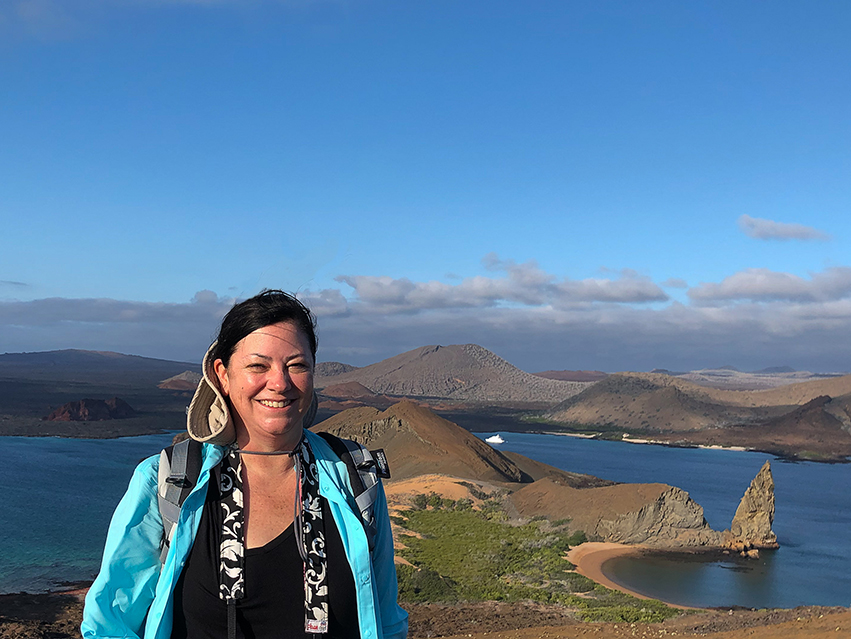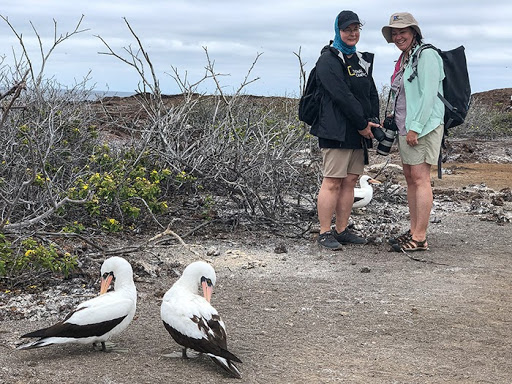
April 28, 2020
Last fall, the textbook came alive for Walker’s science teacher, Dr. Julia Sheldon. She had the opportunity to take a memorable trip to the famed Galápagos Islands as part of an expedition with the National Geographic Society and Lindblad Expeditions. From the first day, she was awe-struck by the animals everywhere around San Cristobal harbor – from crabs to iguanas to sea lions to many different birds.
The opportunity to go to the Galápagos was part of an effort by National Geographic and Lindblad to engage alumni of its Grosvenor Teacher Fellowship program. Dr. Sheldon was a fellow in 2014, which allowed her to go to National Geographic’s headquarters in Washington, DC; travel to Norway and Arctic Svalbard on an expedition; and develop an interdisciplinary elective in Arctic Studies for Walker’s students.
In 2019, Dr. Sheldon was one of just 18 former fellows selected out of more than 125 applicants to travel to the Galápagos for a pilot alumni program. In this interview, Dr. Sheldon tells us more about the program, the trip, and how she plans to bring what she saw to life on campus.
This sounds amazing! Could you transport us to what you saw and experienced on the islands?

It was truly a magical place. We woke up around 6:00 a.m. and drank amazing Ecuadorian coffee and ate an array of interesting tropical fruits – all while we watched the sunrise. It was a wonderful way to start the morning. Every day was full of new adventures, like snorkeling with a very friendly young sea lion who swam right up to my mask before quickly flipping upside down to make a loop and return again.
On another occasion, we visited Genovesa Island and saw many different kinds of birds. I fell in love with birds on my expedition to Svalbard and have been actively birding ever since. The chance to visit this pristine spot and interact with so many unique birds was incredible.
Surprisingly, we also saw some feral animals, including a kitten in the middle of nowhere on our search for land iguanas. We had the opportunity to talk with a veterinarian from Darwin Animal Doctors about the volunteer work he does with dogs and cats on the islands, which was very interesting.
Could you tell us what was so special about going to the Galapagos?
I treasured this opportunity to get back out into the world and experience somewhere so unique and so dedicated to conserving its uniqueness. It’s a place that all my students have heard about and so many people dream of visiting.
I could go on about the trip forever, but a few of the highlights include up-close encounters with the fearless animals; daily snorkeling trips among penguins, sharks and sea turtles; and the chance to get to know another fellow, Kathy Eldridge, from Muscle Shoals, Alabama, and hear about her school community and her experience in Antarctica. These are the unique exchanges that make the program so powerful.

The fellowship gave you the opportunity to interact with National Geographic photographers. This must have been fascinating. Could you tell us more?
I had the privilege of meeting and learning from several National Geographic photographers. It was really a dream come true. I especially remember how photographer C.T. Ticknor shared with me the Hawaiian concept of “kuleana,” the symbiotic relationship between privilege and responsibility. This really struck a chord with me. It has been an important reminder to recognize and utilize the gifts that I have been given and share them with others. My Galápagos expedition is allowing me to find new ways of doing this.
How do you hope to bring what you learned and saw there into your classroom?
The expedition was an incredible privilege that is helping me to better understand the world and the big problems facing our planet – and to recognize, and live up to, my own responsibility to help make things better. I’ve already been sharing my experience with students and the wider Walker’s community. It has been amazing to come back to campus and share all I saw.
My goal is to develop an elective course about climate change and to use my experiences in the Arctic and the Galápagos, two wildly diverse and important ecosystems, as jumping off points for the class. It’s clear that Walker’s students are hungry to learn more about how climate change is affecting our planet and will continue to affect it in the future. I was so pleased to see that more than 30 Walker’s students attended the Hartford Youth Climate Strike last fall and that they are ready to take more action.
Experiencing the Galápagos firsthand has given me so many new things to wonder about and has re-energized my 22nd year of teaching at Walker’s. I am so grateful to the National Geographic Society, LIndblad Expeditions, and the Walker’s community for providing me with this opportunity.